Petunias are one of the most popular plants in landscape design. They are valued for their hardiness, low maintenance requirements, ease of propagation, and long flowering period. Compact bushes delight with abundant blooms from mid-spring until the first frost. If desired, the plant can be overwintered indoors to enjoy again the following year.
The most beautiful variety of petunias is the double-flowered type. It stands out with large, multi-layered blooms featuring numerous petals. The flowers come in various shades, some with striking patterns. Below, we explore the different cultivars of double petunias and how to grow them successfully.
Table of contents
Description of Double Petunias

Double petunias are among the most stunning low-growing flowering plants. Their main advantage over other types is their large, uniquely textured blooms.
The delicate, ruffled petals often have serrated edges and are arranged in multiple layers, giving the flowers a full, voluminous appearance.
Most double petunia varieties produce large flowers, with some exceeding 10 cm in diameter.
Bloom colors vary widely — from pink and deep purple to white, yellow, crimson, and lilac. Bicolored varieties with contrasting edges are particularly popular.
The plants form abundant blooms on compact bushes reaching 15-30 cm in height. Leaves are oval-shaped, bright green, with slightly pointed tips.
Flowering lasts from late spring until the first autumn frosts. Although technically perennial, in most European climates they're grown as annuals.
Note! To preserve your petunias, bring them indoors during winter. In spring, you can take numerous cuttings from the overwintered plant.
While generally low-maintenance, double petunias have some specific cultivation requirements.
Popular Double Petunia Varieties and Hybrids
The selection of double petunia cultivars expands every year. They differ in flowering duration, bloom size and color, disease resistance, and plant height.
Note! Leading European seed producers include Thompson & Morgan, Suttons, and Bakker.
Large-flowered Valentina F1
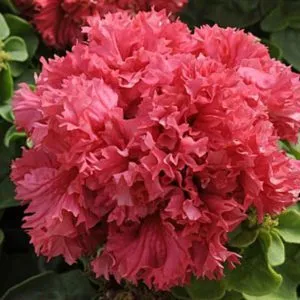
The Valentina hybrid is among the most beautiful double petunias. It flowers early, maintains vibrant color, and shows excellent environmental stress tolerance.
Flowers measure 7-10 cm across, with spherical, deeply ruffled bright red petals featuring pronounced serrations.
Plants reach 30-40 cm in height, forming wide, branching bushes.
Burgundy
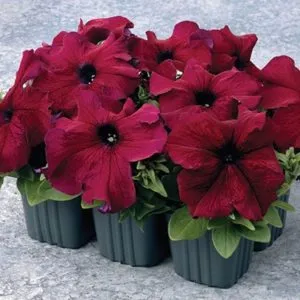
The Burgundy hybrid withstands cool temperatures, rainy conditions, and windy weather exceptionally well. It's highly disease-resistant, making it perfect for beginners.
The 10 cm flowers feature densely packed double petals, creating exceptionally full blooms.
The rich burgundy-colored flowers cover the plant so completely they nearly obscure the foliage. Blooms appear continuously from May through October.
White Sonata

The White Sonata hybrid (often mistakenly called a variety) impresses with its exceptionally early flowering — blooms appear as early as April, a month before most other types.
The fully double white flowers reach 12 cm across, with multiple layers of ruffled petals.
The pure white blooms completely cover the plant. Maximum height is 35 cm. This hybrid tolerates cool weather remarkably well.
Double Cascade Blue
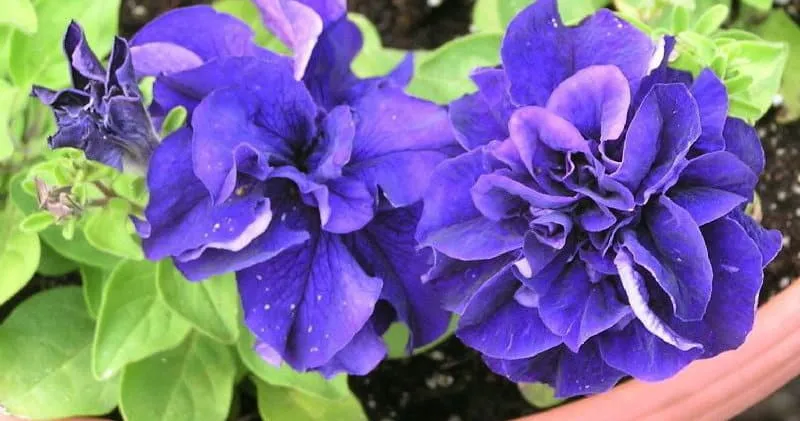
Double Cascade Blue stands out with its unusual flower color — one of the most distinctive hybrids available.
The large, 10-13 cm flowers feature wavy, serrated petals forming nearly spherical blooms.
The deep violet petals have a silvery sheen from fine hairs on their inner surface.
Despite the large flowers, plants remain compact at just 12-15 cm tall.
Pirouette

Pirouette is a landscape designer favorite. The enormous, 15 cm flowers resemble fluffy balls with intensely ruffled petals, appearing in great profusion.
Most Pirouette varieties feature white-edged petals in various colors. Occasionally, solid white or pink flowers with minor variegation may appear.
Plants stay low at about 15 cm tall.
The standout in this series is Pirouette Purple — violet flowers with crisp white edges.
Duo
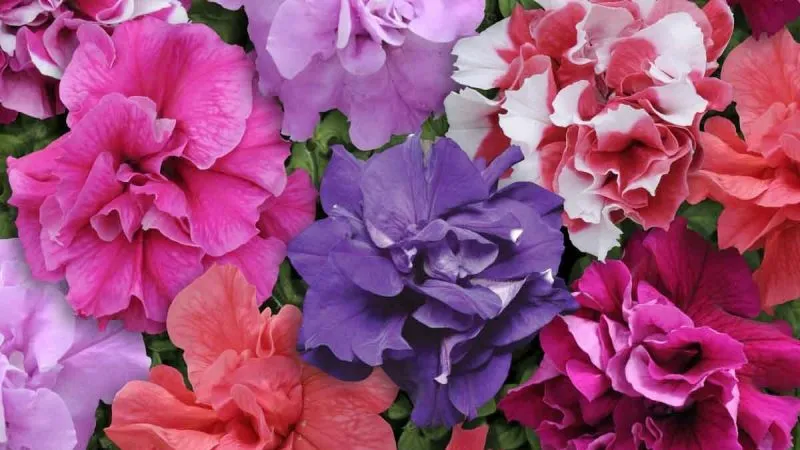
Duo petunias offer simpler flowers but exceptional ease of growth, making them popular with novice gardeners.
The 6 cm flowers come in red, purple, pink, magenta, and violet shades.
For double petunias, Duo plants are relatively tall at 35 cm.
Note! Several Duo hybrids exist: Duo Rose and White, Duo Red and White, Duo Marzipan, Duo Salmon, and Duo Lavender — differing primarily in color combinations.
Multiflora Tart Bonanza

Tart Bonanza offers the most vibrant color display among multiflora petunias.
Flowers appear in violet, blue, pink, lilac, and red shades, some with white petal edges.
The 5-7 cm blooms feature ruffled but unsplit petals.
Growing Double Petunias
These beautiful plants are quite undemanding, suitable even for gardening beginners.
Tip! The compact size makes double petunias perfect for bordering flower beds.
Growing from Seeds or Cuttings
Petunias propagate both vegetatively (from cuttings) and generatively (from seeds).
From Seeds

Not all petunias produce viable seeds — some must be propagated vegetatively. Even seed-producing varieties rarely come true from saved seeds, so purchased seeds are recommended.
Seeds come either pelleted (easier to handle) or loose (more economical).
Commercial seeds typically require no pretreatment. If uncertain, soak seeds for 30 minutes in a pale pink potassium permanganate solution.
Sow seeds in containers with drainage and potting mix, pressing them lightly into the surface without covering. Mist the soil with water (optionally with a growth stimulant), cover with plastic, and place in warmth until germination.
Maintain moisture by misting until germination, then water carefully at soil level. Gradually increase ventilation before removing the cover entirely.
Transplant seedlings to individual containers after two true leaves appear. Clear plastic cups work well. Repot again when roots fill the container.
From Cuttings
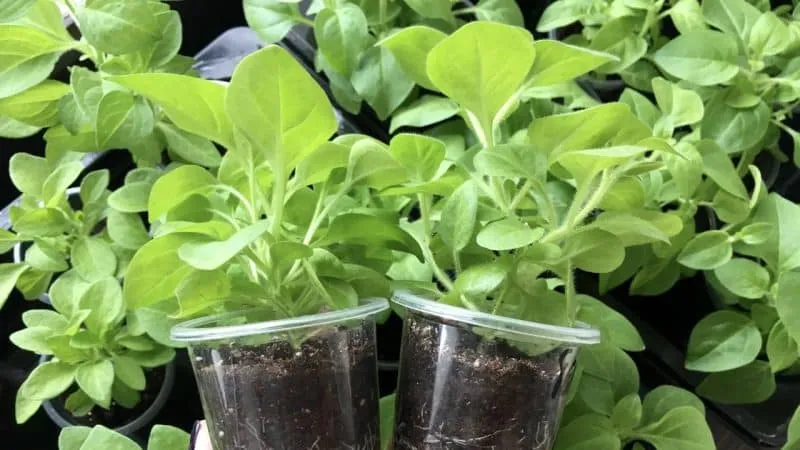
Vegetative propagation is simpler. Purchase young plants from nurseries or take cuttings from overwintered specimens.
For cuttings, select 10 cm healthy stem sections with at least two nodes. Remove all leaves except the top pair.
Insert cuttings into moist potting mix or sand until they stand upright. A shared container works well. Cover with plastic.
Note! Double petunias root poorly in water.
Ventilate cuttings daily. Water at soil level as needed.
After rooting (1-2 weeks), transplant to individual pots without burying the stem.
Soil Requirements
Use the same soil mix for both propagation methods — either commercial potting soil for flowers or seedling mix.
For homemade mix, combine equal parts garden soil, compost, and sand. Add 1 cup wood ash per 10 liters of mix.
Sterilize all soil by drenching with dark pink potassium permanganate solution or copper sulfate.
Planting Outdoors
Transplant outdoors in March or April, depending on local temperatures. Harden off plants for a week before planting.
Prepare beds by digging and removing weeds. Per square meter, incorporate 5 kg well-rotted manure, 30 g superphosphate, and 25 g potassium sulfate.
Space plants at least 30 cm apart. Plant at the same depth as in pots. Water thoroughly after planting.
Important! Shape plants early by pinching the main stem above the third leaf pair to encourage bushiness.
Ongoing Care
Follow these basic care guidelines for thriving petunias.
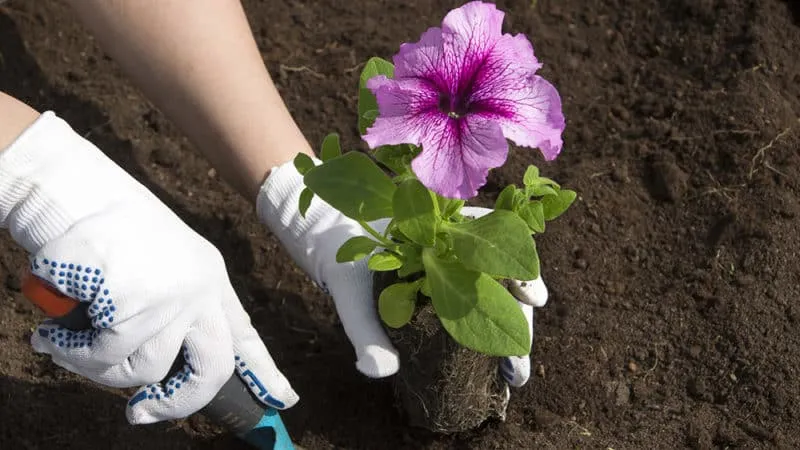
Watering
Water when soil dries, typically every 2-3 days (more frequently in hot weather). Use room-temperature water.
Soil Cultivation
Loosen soil after watering to prevent compaction and root issues. Remove weeds simultaneously.
Mulching
Mulch suppresses weeds, protects roots, and reduces watering needs. Use compost, straw, or bark around plants.
Fertilizing
Feed every two weeks during flowering with commercial fertilizer or homemade mix:
For mineral fertilizer: 10 liters water, 25 g potassium sulfate, 35 g superphosphate, and 2 tbsp urea.
For organic option: chicken manure diluted 1:10 with water.
Deadheading
Remove spent blooms to encourage continuous flowering. Leaving flowers to seed reduces bloom production.
Pest and Disease Prevention
Prevent problems with these measures:
- Regular weeding
- Consistent soil cultivation
- Sterilizing soil, containers, and tools
- Spring copper sulfate spray
- Avoiding cold water for irrigation
Conclusion
Double petunias offer the most spectacular blooms in the petunia family — large, lush, and vibrantly colored all summer long. With proper winter care, they can be enjoyed for multiple seasons.
Growing double petunias is no more challenging than other types. Their resilience and adaptability make them excellent choices for European gardens.







